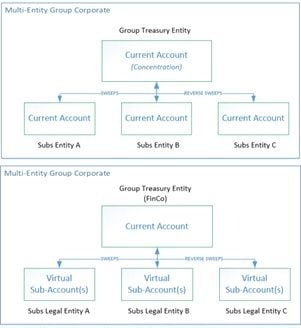Home > Blogs > Virtual accounts – the next big thing in liquidity management
Virtual accounts – the next big thing in liquidity management

In the present globalized world, big corporates have their business operations spread across continents and countries. As a legal entity in different countries, they open bank accounts based on their relationship with different global banks. In these cases, it is very difficult for the global finance controller to see their consolidated liquidity and manage them based on their requirements.
Banking laws are tightly coupled, and account-related information as well as transfer of funds from one account to another account in different countries is governed by the respective countries’ banking laws. And taking services from expensive payment gateways like SWIFT may not be the best solution to manage this.
Virtual accounts, where actual accounts are not disclosed to the payers, are in use for a long time for collection purposes and are an effective alternative to overcome this barrier. This process is widely known as COBO – Collections-On-Behalf-Of. Banks when receive funds in these virtual accounts, pass the respective credits into the actual account of merchant/corporate.
In today’s world, the usage of virtual account has been extended to managing global liquidity by corporate treasurer, as controlling banking accounts and its liquidity in each country is very expensive and expensive to administer. Now, global treasury departments need real time information on funds being paid or received by its subsidiaries across the globe, so appropriate sweeping targets at balancing liquidity functions can be performed and managed better.
Functions in Virtual Account Management
Typical structure of Virtual Account Management

In the above example, in figure 1, without the presence of virtual account, individual banking accounts are maintained in each entity. This in turn increases operational and administrative cost of the corporate. To minimize this effect, virtual accounts are opened under one operational current account. Under VAM, corporate treasury department can view the consolidated liquidity in one physical account and can perform all working capital methodology to manage funds in respective entities.
Benefits of VAM Solution
Corporate Dashboard for VAM
Corporate treasury department requires a dashboard view of all its virtual accounts, its structure, real time balances and interest component. This would be required so that the global department can monitor liquidity and check for its working capital requirements. This also helps the corporate in better reconciliation of its payables and receivables.
A quick summary of virtual accounts and VAM platforms:
Leave a Reply
8 thoughts on “Virtual accounts – the next big thing in liquidity management”
-
Good one! Interesting article over here. It’s pretty worth enough for me.
-
Like!! Thank you for publishing this awesome article.
-
Like!! Great article post.Really thank you! Really Cool.
-
Like!! Really appreciate you sharing this blog post.Really thank you! Keep writing.
-
Innovative Solution. Great value for Large Multinational entities or corporations that has footprint in many countries.
-
Innovative Solution. Great value of Large Multinational entities or corporations that has footprint in many countries.
-
Informative with good example. Somehow I see it becomes a big thing in retail consumer market too.
-
Great article. Neatly explained
Load more comments...


Ankit Batwara
More blogs from Ankit Batwara >